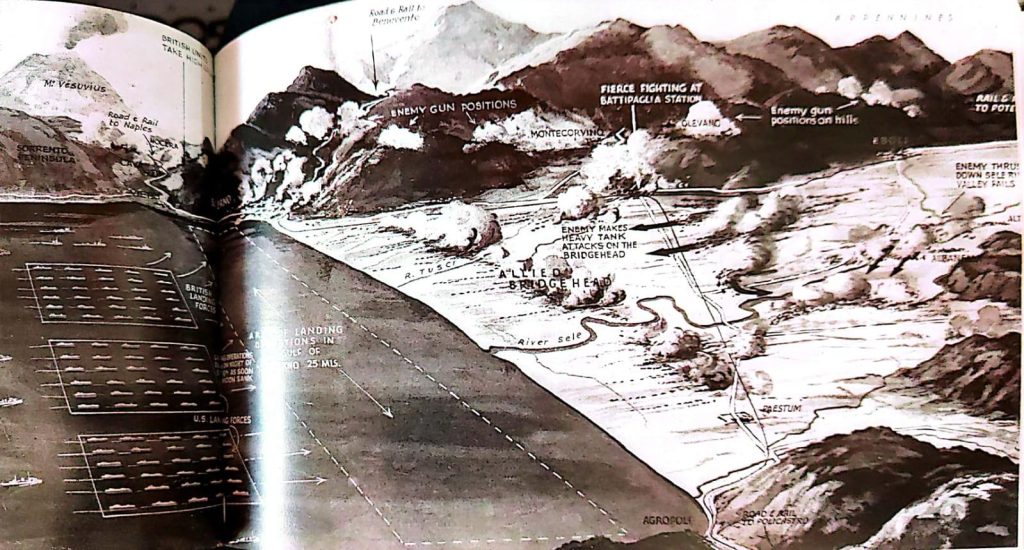by Alessia Petrucci

La Grotta di San Michele ad Olevano sul Tusciano, luogo di grande valore religioso e devozionale, è stata meta di pellegrinaggi sin dal Medioevo, già ai tempi dei Longobardi. Durante la Seconda Guerra Mondiale, divenne un rifugio importante per le molte persone che, a causa dei bombardamenti, fuggivano dalla pianura in cerca di sicurezza nelle zone montuose.
Le aree di Salerno e Battipaglia non furono solo teatro dello sbarco degli Alleati, ma anche di numerosi scontri con le forze tedesche. Durante e dopo i giorni dello sbarco, l’azione militare dei tedeschi, che cercavano di difendersi dagli attacchi anglo-americani, proseguì con distruzioni. Molte persone decisero di abbandonare le proprie case, o quel che ne restava, per mettersi in salvo e proteggere le proprie famiglie.
Una testimonianza diretta di quei giorni ci arriva da Carlo Carucci, uno dei pochi testimoni oculari di quei tragici eventi. Originario di Olevano, tornò nel suo paese natio (Borgata Valle) con la moglie per cercare rifugio. Carucci ha scritto una descrizione dettagliata, giorno per giorno (dal 9 al 30 settembre), delle esperienze vissute da lui e dagli altri abitanti. Dalla cima dei monti di Olevano, era possibile osservare i movimenti degli eserciti e, dalla distanza dei colpi, intuire le zone interessate dai combattimenti.
Poiché le chiese erano state distrutte, le grotte divennero luoghi dove si celebravano Messe e si recitavano preghiere e rosari, affidandosi a Dio per chiedere protezione. La Grotta di San Michele, in quei giorni, non solo accoglieva le persone e i loro beni (animali e oggetti di valore), ma anche oggetti sacri.
La città di Battipaglia fu praticamente distrutta, e a causa dei bombardamenti la chiesa di Santa Maria della Speranza (oggi Santuario della cittadina dal 1980) crollò. Nonostante ciò, la statua della Madonna, che aveva perso solo tre dita della mano destra, fu portata quasi intatta nella Grotta di San Michele il 25 agosto 1943. Fu solo nell’aprile del 1944 che la statua tornò a Battipaglia, quando la chiesa, seppur parzialmente, fu riparata.
Ancora oggi la Grotta di San Michele conserva il suo valore religioso, ed è meta di pellegrinaggi, soprattutto da parte degli abitanti di Olevano. Due sono le date significative:
Nel 2017, la Grotta è stata interessata da un vasto incendio che, fortunatamente, non ha danneggiato né la grotta stessa né gli affreschi longobardi che ancora si possono ammirare al suo interno.



Bibliografia
C. Carucci, La Battaglia di Salerno settembre 1943
Sitografia
https://www.agendaonline.it/salerno/comuni/battipaglia.htm
http://www.olevanosultuscianoarte.it/2017/01/15/grotta-dellangelo-san-michele/
https://www.grottadisanmicheleolevano.it/storia.html
A place with a strong religious value and a place of devotion, a pilgrimage site already during the Middle Ages with the Longobards, San Michele’s Cave in Olevano sul Tusciano became an important place , of protection, for many people who fled the plaun to seek refuge in montainous areas because of the bombing.
The areas of Salerno-Battipaglia were theatre , not only of the landing of the allies but also of numerous clashes with Texian armies. During and after the days of the landing, the Germans continued their destructive military action to defend themselves from the Angli-American attacks . Then a lot of people decided to leave their home, or what there was left of it, trying to save their own lives and those of their loved ones.
A careful, meticulous and sometimes subjective description comes to us from one of the eyewitnesses of those days, Carlo Carucci. Originally from Olevano he came back to his native place (Borgata Valle) from Salerno, with his wife, to find a refuge.
Carucci gives us a description day by day ( from the 9th of September to the 30th) of what he and other people live . From the top of the mountains of Olevano the advance of the armies can be seen and understand by the distance or proximity of the shots the affacted places.
In different caves, because churches were destroyed, Masses were celebrated and prayers and rosaries were recited to trust in God and ask for his help.
San Michele’s cave , in those days, became a place of protection not only for people and their goods (animals and small objects) but even for sacred objects.
The city of Battipaglia was in fact destroyed and because of the bombing Santa Maria della Speranza’s church ( the Sanctuary of the town from 1980) collapsed. From that distruction it came out almost untouched , loosing only three fingers of the right hand , Madonna’s statue which was brought to San Michele’s cave on the 25th of August of 1943. Only in april of 1944 the statue returned to Battipaglia, when the church was repaired, even if only partially.
Nowadays San Michele’s cave still preserve all its importance, it is still a pilgrimage site mainly by the inhabitants of Olevano. There are two important appointments:
The cave, in 2017, was protagonist of a vast fire accident that has not damaged neither it nor the Lombard frescoes still visible inside.